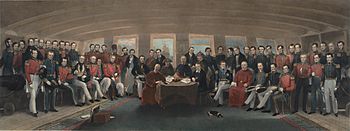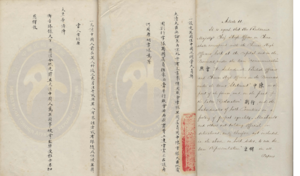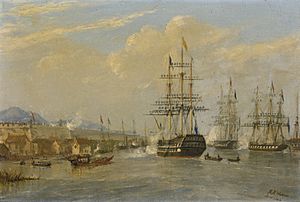Treaty of Nanking facts for kids
| Treaty of Peace, Friendship, and Commerce Between Her Majesty the Queen of Great Britain and Ireland and the Emperor of China | |
|---|---|

Signing of the treaty on board HMS Cornwallis
|
|
| Signed | 29 August 1842 |
| Location | Nanjing (Nanking), Qing Empire |
| Effective | 26 June 1843 |
| Condition | Exchange of ratifications |
| Parties | |
| Languages | English and Chinese |
| Treaty of Nanking | |||||||||||||||
|---|---|---|---|---|---|---|---|---|---|---|---|---|---|---|---|
| Traditional Chinese | 南京條約 | ||||||||||||||
| Simplified Chinese | 南京条约 | ||||||||||||||
|
|||||||||||||||
The Treaty of Nanking was a peace treaty signed on August 29, 1842. It officially ended the First Opium War (1839–1842) between Great Britain and the Qing dynasty of China. This treaty was the first of several agreements that the Chinese later called the Unequal Treaties.
After China's military defeat, British warships were ready to attack Nanjing. So, British and Chinese officials met on board HMS Cornwallis, a ship anchored in the Yangtze River. On August 29, British representative Sir Henry Pottinger and Qing representatives Qiying, Yilibu, and Niu Jian signed the treaty. It had thirteen main points.
The Daoguang Emperor of China approved the treaty on October 27. Queen Victoria of Britain approved it on December 28. The final exchange of approvals happened in Hong Kong on June 26, 1843. The treaty made China pay money to Britain. It also gave Hong Kong Island to Britain as a colony. The treaty changed the Canton system, which had limited trade to only one port. Now, trade was allowed at five "Treaty Ports." A year later, the Treaty of the Bogue was signed. This treaty gave Britain special rights, like extraterritoriality (meaning British people in China were judged by British laws) and "most favored nation" status.
Contents
Why the Treaty Was Needed
In the late 1700s and early 1800s, Britain bought many goods from China. These included tea and porcelain. However, Britain did not have many goods that China wanted to buy. This created a trade problem for Britain.
To fix this, Britain started growing opium in British India. This opium was then sold to merchants. These merchants smuggled the opium into China, even though Chinese law said it was illegal. When Chinese official Lin Zexu seized and destroyed a large amount of this smuggled opium, Britain demanded payment. This disagreement led to the First Opium War. Britain had newer military technology, which helped them win the war easily. This victory allowed Britain to force China to sign a treaty that mostly benefited Britain.
What the Treaty Said
Changes to Foreign Trade
A main goal of the treaty was to change how foreign trade worked. Before, the "Canton System" had controlled trade since 1760. Article V of the treaty ended the monopoly of the Cohong merchants and their Thirteen Factories in Canton.
The treaty opened four new "treaty ports" for foreign trade. These were Xiamen, Fuzhou, Ningbo, and Shanghai. Foreign merchants could now trade with anyone they wanted in these ports. Britain also gained the right to send consuls (officials who represent their country) to these ports. These consuls could talk directly with local Chinese officials (Article II). The treaty also said that trade in these ports would have fixed taxes, which Britain and China would agree on (Article X).
Payments and Peace Terms
The Qing government had to pay the British government 6 million silver dollars. This was for the opium that Lin Zexu had taken in 1839 (Article IV). China also had to pay 3 million dollars to British merchants. This was to cover debts that Chinese merchants in Canton owed them (Article V). On top of that, China paid 12 million dollars for the cost of the war (Article VI).
The total payment was 21 million dollars. China had to pay this money over three years. If payments were late, China would be charged an extra 5 percent interest each year (Article VII).
The Qing government also promised to free all British prisoners of war (Article VIII). They also agreed to forgive all Chinese people who had helped the British during the war (Article IX).
In return, Britain promised to remove its troops from Nanjing, the Grand Canal, and Zhenhai. Britain also agreed not to interfere with China's trade. This would happen after the Chinese emperor approved the treaty and the first payment was made (Article XII). However, British troops would stay in Gulangyu and Zhaobaoshan until China paid all the money (Article XII).
Hong Kong Island Becomes British
In 1841, a rough plan for the treaty was sent to the British representative, Charles Elliot. It had a blank space for which islands would be given to Britain. Later, Henry Pottinger changed this draft. He crossed out "islands" and wrote in "Hong Kong."
The Qing government agreed to give Hong Kong Island to Queen Victoria of Great Britain forever (Article III). This was to give British traders a safe harbor where they could repair their ships and store supplies. Pottinger later became the first Governor of Hong Kong.
Later, in 1860, the Kowloon peninsula was added to the colony under the Convention of Peking. In 1898, the Second Convention of Peking further expanded the colony. This added the New Territories under a 99-year lease. In 1984, the United Kingdom and the People's Republic of China agreed that all of Hong Kong would be returned to China on July 1, 1997.
What Happened Next
The treaty was formally sealed by British interpreter John Robert Morrison and Chinese official Wang Tajin.
The Daoguang Emperor approved the treaty on September 8. After his approval reached Nanjing on September 15, Pottinger's secretary, George Alexander Malcolm, took a copy to Britain for Queen Victoria to approve. The emperor officially approved the treaty on October 27, and Queen Victoria approved it on December 28. The final exchange of approvals happened in Hong Kong on June 26, 1843.
Because the Treaty of Nanking was quite short and its terms were general, Britain and China agreed to make another treaty. This new treaty would add more detailed rules for their relationship. So, on October 3, 1843, they signed the supplementary Treaty of the Bogue near Canton.
However, these treaties from 1842–43 did not solve all problems. For example, they did not make the opium trade legal for the British Empire. Even though the Treaty of Wanghia in 1844 banned Americans from selling opium, the trade continued. This was because British and American merchants were only subject to their own consuls' laws. The opium trade was later made legal in the Treaties of Tianjin. China signed these treaties after losing the Second Opium War.
These treaties had a big and lasting impact. The Treaty of Nanking, along with later treaties in 1843, 1858, and 1860, ended the Canton System. They created a new way for China to deal with foreign countries and trade. This new system lasted for almost a hundred years. It marked the start of what Chinese nationalists later called China's "century of humiliation."
From the view of modern Chinese nationalists, the worst parts of these treaties were the fixed trade taxes, extraterritoriality, and the "most favoured nation" rules. Also, allowing British opium to be imported continued to cause social and economic problems for the Chinese people. Britain forced these terms on China. Other Western powers also gained these benefits because of "most favored nation" status. The Qing dynasty agreed to these terms to avoid more military defeats. They also hoped that the "most favored nation" rule would make the foreign powers compete against each other. China regained control over its trade taxes in the 1920s. However, extraterritoriality was not officially ended until 1943 with the Sino-British Treaty for the Relinquishment of Extra-Territorial Rights in China.
A copy of the treaty is kept by the British government. Another copy is kept by the Ministry of Foreign Affairs of Republic of China at the National Palace Museum in Taipei, Taiwan.
Images for kids
See also
- Western imperialism in Asia
- History of Hong Kong
- Anglo-Chinese relations
- Henry Collen (photographed the treaty)
- David Sassoon




